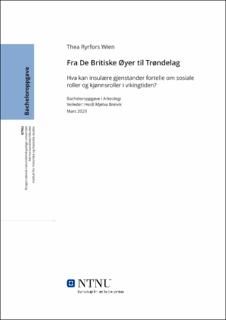| dc.contributor.advisor | Breivik, Heidi Mjelva | |
| dc.contributor.author | Wien, Thea Ryrfors | |
| dc.date.accessioned | 2023-05-19T17:19:37Z | |
| dc.date.available | 2023-05-19T17:19:37Z | |
| dc.date.issued | 2023 | |
| dc.identifier | no.ntnu:inspera:140999755:68694700 | |
| dc.identifier.uri | https://hdl.handle.net/11250/3068371 | |
| dc.description.abstract | Temaet for denne bacheloroppgaven er insulære funn i Trøndelag, og hva disse funnene kan fortelle om vikingenes forhold til dem, sosiale roller og kjønnsroller i vikingtiden. Problemstillingene er: Var de insulære gjenstandene som kom til Trøndelag i løpet av vikingtiden luksusgjenstander forbeholdt menneskene i det øverste sjiktet i samfunnet? Kan de insulære funnene bevitne at både menn og kvinner kunne ha viktige posisjoner i samfunnet i vikingtiden? For å svare på problemstillingene tar jeg for meg de insulære funnene fra Trøndelag, og det blir lagt mest vekt på gravfunnene. Forskjellige teorier om hvorfor vikingene satte ut på reise, og motivasjonen deres bak importen av de insulære gjenstandene blir diskutert i teksten. Et utvalg av de 35 vikinggravene med insulære gjenstander blir trukket frem from å diskutere problemstillingen. For å vurdere gravene blir Lotte Hedeagers AOT-modell brukt. Resultatene viser at de fleste gravene var rike graver, eller middels rike graver, og at selv flere av de fattigste gravene kan vurderes til å tilhøre velstående personer. Konklusjonen til oppgaven er at de insulære gjenstandene var verdifulle og prestisjefylte gjenstander for vikingene, og de var eid, og brukt av personer i det øverste sjiktet, og at både kvinner og menn som kunne ha slike viktige sosiale posisjoner i samfunnet. | |
| dc.description.abstract | The theme for this bachelor thesis is insular objects that were imported to Trøndelag during the Viking-age, and what these objects can tell us about the Vikings’ relationship to them, social roles, and gender roles in the Viking Age. My thesis questions are: Were the insular objects that were imported to Trøndelag during the Viking-age luxury objects reserved for the people belonging to the upper class in society? Can the insular finds prove that both men and women could have important positions in society in the Viking Age. In order to answer these questions, the thesis looks at the insular finds from the Viking Age in Trøndelag, however, the main focus will be on the burial finds. Different theories as to why the Vikings set out on their journeys, and their motivation behind the import of the insular artefacts are discussed in this text. A selection of the 35 Viking-graves with insular artefacts is chosen to discuss the thesis questions. To assess the graves, Lotte Hedeagers AOT-model is used. The results show that a majority of the graves were rich, or somewhat rich, and that even several of the poorer graves may be considered to have belonged to wealthy people. The conclusion of the thesis is that the insular objects were valuable and prestigious for the Vikings, and they were owned and used by people belonging to the upper class in society, and both men and women could have important social roles in society. | |
| dc.language | nob | |
| dc.publisher | NTNU | |
| dc.title | Fra De Britiske Øyer til Trøndelag
Hva kan insulære gjenstander fortelle om sosiale roller og kjønnsroller i vikingtiden? | |
| dc.type | Bachelor thesis | |
